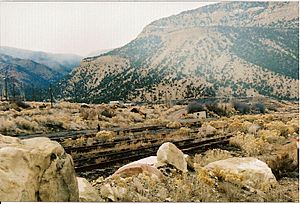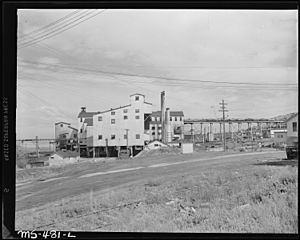Hiawatha, Utah facts for kids
Quick facts for kids
Hiawatha, Utah
|
|
|---|---|

A few of the structures left at Hiawatha, November 2007
|
|
| Country | United States |
| State | Utah |
| County | Carbon |
| Incorporated | 1911 |
| Disincorporated | November 20, 1992 |
| Named for | Hiawatha, a pre-colonial Native American leader |
| Elevation | 7,264 ft (2,214 m) |
| GNIS feature ID | 1428681 |
Hiawatha is a small place in Carbon County, Utah, United States. It's called an "unincorporated community" because it doesn't have its own local government. It's also known as a "near-ghost town" because most people have moved away.
Hiawatha used to be a busy coal mining town. While most of it was in Carbon County, a tiny part stretched into Emery County. It was also close to the Manti-La Sal National Forest.
Contents
About Hiawatha: A Former Mining Town
Hiawatha is found at the bottom of Gentry Mountain. It's about 12 miles (19 km) southwest of a larger city called Price. This area was once a lively town, especially in the 1940s, when over 1,500 people lived there.
How Hiawatha Started
Coal was first found in Hiawatha in 1909. Soon after, a mine was built to dig up the coal. A railroad was also constructed to carry the coal away. The town officially became a city in 1911. In 1915, another nearby village called Blackhawk joined with Hiawatha.
Life in a Company Town
Hiawatha was a "company town". This means that the United States Fuel Company, which owned the coal mine, also owned and managed most of the town. They had their main office there and basically ran everything.
| Historical population | |||
|---|---|---|---|
| Census | Pop. | %± | |
| 1920 | 1,436 | — | |
| 1930 | 939 | −34.6% | |
| 1940 | 858 | −8.6% | |
| 1950 | 1,421 | 65.6% | |
| 1960 | 439 | −69.1% | |
| 1970 | 166 | −62.2% | |
| 1980 | 249 | 50.0% | |
| 1990 | 43 | −82.7% | |
After the 1940s, the amount of coal being mined started to decrease. Because of this, many people began to move away from Hiawatha. The population dropped a lot, from 439 people in 1960 to just 43 people by 1990. On November 20, 1992, Hiawatha officially stopped being a city.
Hiawatha Today
Even though it's mostly a ghost town, there have been efforts to bring Hiawatha back to life. In 1997, a company called Hiawatha Coal Company took over the mining permits. They have plans to start mining again in the future.
In 2006, the local government in Carbon County changed the rules for some parts of Hiawatha. They allowed three of its six sections to be used for homes. This was requested by the property owner, ANR Inc. Today, only about three or four families live in Hiawatha. Some houses have been fixed up, and new building work is still happening.
Hiawatha was also special because it had a lively community of Greek immigrants. Many of these families came from the island of Crete.
Climate in Hiawatha
The weather in Hiawatha has big changes between seasons. Summers can be warm to hot, and sometimes humid. Winters are cold, and can be very cold at times. According to the Köppen Climate Classification system, Hiawatha has a "humid continental climate." This type of climate is shown as "Dfb" on climate maps.
See also
 In Spanish: Hiawatha (Utah) para niños
In Spanish: Hiawatha (Utah) para niños




